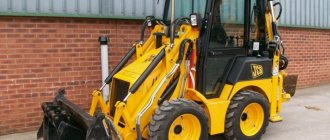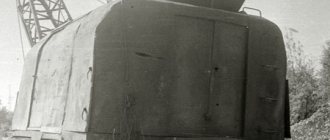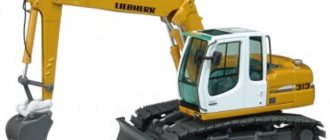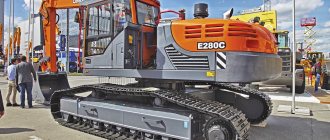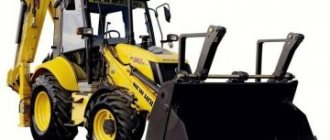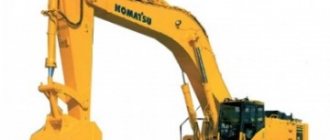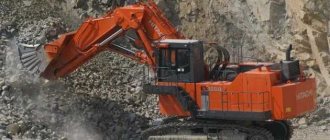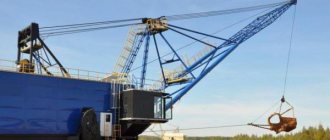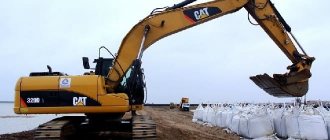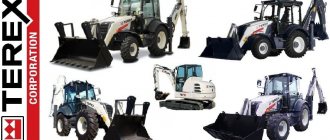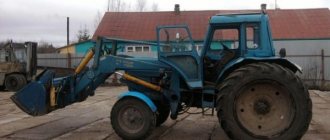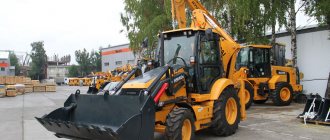Backhoe loaders are modern multifunctional equipment used in various spheres of the national economy. The Russian market offers a huge selection of models from different manufacturers. Which backhoe loader is better to choose? Each option has its advantages: one is more powerful and reliable, the other has an increased digging depth, the third has a comfortable cabin, and so on.
Therefore, it is sometimes difficult to determine which manufacturer of tracked or wheeled backhoe loaders is better, and which model to choose? Our review of special equipment is designed to help you decide. It was compiled based on an analysis of the technical characteristics of the equipment, comments from experts and reviews from equipment owners.
Which crawler excavator is better?
So let’s continue, I’ll write the pros and cons from the operator’s side (who is just digging) and from the service department’s side (the one who services these machines).
The whole discussion here will be about the Doosan Solar series, both wheeled and tracked vehicles (who doesn’t know - this is the former Daewoo Heavy Industries (South Korea) Pros (operator) 1. Good visibility from the cab 2. Smooth control. By the way, at the base at a meeting held by our company with construction organizations, they organized a competition. Anyone was asked to open a beer bottle while driving a Doosan Solar 210w-v wheeled excavator. 8 out of 10 people managed to do this. These people had never driven an excavator before. 3. The presence of air conditioning. It helps a lot in the summer and warms in winter. 4. Low noise level in the cabin. 5. Very comfortable seat. 6. There is a thermo and refrigerator compartment. In the summer you can always drink cold water (lemonade, beer?) 7. There is a radio tape recorder 8. There is a 12V socket for charging a mobile phone 9. Informative LCD display on which you can monitor the operating pressure in the systems.Indication of the time of use of filters and oil (9 positions) 10. Reasonable saturation with electronics, only two modes: digging mode and trenching mode. The Epos system controls engine operation. 11. Convenient location of the lubrication line, the volume of the hinges is reduced to a minimum, which speeds up the lubrication process. Due to the safety sealing rings, the penetration of dust from outside is minimal. 12. The water separator is installed in a place easily accessible from the ground. 13. Wheeled excavators run very fast (automatic transmission). The stated speed is 35 km/h. The real one is 15 km/h higher, that is, they run about 50 km/h 14. There is a fuel transfer pump with a long hose. 15. There is a “button” for increasing digging. Sometimes it helps a lot.
Pros (from the side of mechanics and general pros) 1. Ports for measuring pressure and flow are conveniently located. 2. Valves (main and safety) are conveniently located 3. The machines correspond to the diagrams and catalogs supplied with the machines. 4. It is convenient to change oils, the drain ports are located very conveniently 5. A very simple program for testing electronics 6. The hydraulic system is made of very high quality. The main components and assemblies of world manufacturers from Japan and Germany were used. 7. Convenient to use at Northern latitudes. You just need to fill in the appropriate oils and install the engine pre-heater. 8. Engines of our own design are of very high quality. Some machines have larger engines than their competitors. 9.Easy to adapt to high mountain areas. It is easy to change the fuel supply volume. 10. Blade cylinders are well protected. 11. Availability of hydraulic lines for attachments. 12. Easily adjustable hydraulic oil supply (pressure) for attachments 13. Hydraulic locks and safety valves are made very simply. 14. Convenient radiator cleaning. 15. Brushless alternator is insensitive to dust, heavy duty.
Cons (operator) 1. There is no way to control the temperature of the hydraulic oil. 2. On tracked vehicles, a “corrugated track” would be much better. 3. Inconveniently located fuel pump 4. Weak protection of headlights
Disadvantages (on the part of mechanics and general disadvantages) 1. There is no way to monitor the pressure in the gearbox (wheel drives) 2. It is difficult to adjust the brake system (you need to disassemble half of the hub) 3. It is inconvenient to drain the oil from the rotary gearbox 4. It is not convenient to change the cabin filter 5. Not a quick-release bucket 6. It’s not convenient to get to the fuel filters. 7. The wheeler does not have “ears” for emergency transportation
Well, that’s probably all.. If someone continues the list of “pros” and “cons”, then I’m all for it. We are ready to listen and record customer wishes for modifications to Doosan excavators. Let's make technology even better together.
2Frantik. The cost of wheeled vehicles is truly one of the best, and the machines justify themselves.
As one of the clients said: “There are no good excavators; they don’t break only when they stand against the fence!” And they all break in the same way, like Cat, Komatsu, Hitachi and everyone else.” (vehicle fleet of about 200 excavators from various manufacturers)
“Zero” and shortened rear overhang
Due to the larger working radius of mid-range excavators, they require a large counterweight, which usually protrudes from the rear of the superstructure. But when working in tight spaces, the protruding rear end gets in the way of the excavator. Therefore, models with reduced or “zero” rear overhang are popular, for example, with utilities and road services, and manufacturers have taken this need into account: a number of companies have released models of mid-range excavators with “zero” or reduced rear overhang (for example, only 100 mm), which Previously they were found only among mini-excavators. Designers of new models of middle-class excavators manage to place a heavy counterweight on the machine, while reducing the rear overhang. Such machines can operate in one lane of the road without blocking adjacent ones, and the operator can concentrate on bucket work without worrying about the rear end colliding with an obstacle.
Models with zero and reduced rear overhang in the class under consideration do not yet make up the majority of sales, but their share is growing rapidly, and in the range of crawler excavators weighing 12–16 tons, models with minimal and “zero” rear overhang already predominate.
Models weighing about 8.5 tons almost always have a “zero” or shortened rear overhang and a rotating boom, which, in combination with a bucket rotator, allows you to remove soil with “jewelry” precision in extremely cramped conditions. The pivoting boom is an advantage that attracts buyers to these models. As a rule, such machines are equipped as standard with additional hydraulic circuits, the flow rate of which is 50% of the capacity in the main hydraulic circuit. They are widely used for mounting equipment such as thumb grips. Thanks to the presence of an additional circuit, the gripper is always ready for use, and the main hydraulic circuit remains free for the installation of tools such as vibrating plates and hydraulic drills, which require high hydraulic performance. In addition, these excavators can be equipped with quite powerful hydraulic hammers, large buckets and grips, with which they can successfully carry out work on demolishing buildings and processing construction waste.
Models weighing about 8.5 tons are available in the lineups of many manufacturers, often after this model there is a “gap” to models weighing about 13.5 tons. One of the main advantages that attracts consumer interest in these machines is the size of their cabins. This, of course, is not the cabin of a full-size car, but it is very close to it, at least in length, and the new models have even wider cabins. The cabs feature modern seats and position-adjustable controls. The engine power of such machines is usually 55–65 hp, and the digging depth is on average about 4300 mm, although a number of models have a digging depth exceeding 4600 mm. Rubber tracks are usually standard, but steel tracks are available as an option on many models. Typically, a blade is also installed as standard or upon request.
Models with “zero” rear overhang are very versatile, while the overhang is minimally reduced. Some of these models offer the option of larger counterweights that increase machine stability and lifting capacity (by approximately 15%) and are especially useful on machines equipped with a thumb grip on the boom. The additional counterweight slightly increases the rear reach of the machine, by approximately 150–230 mm.
Types of excavators
There are several main types, depending on the operating conditions for which they are intended:
- Universal. Typically used in construction. They are distinguished by their medium size, good maneuverability and high performance.
- Mine. They are made as compact as possible so that the machine can easily maneuver in confined spaces. Used in mines and tunnels.
- Career. Equipment in this segment is represented by a huge variety of sizes and characteristics. All models feature a large bucket that allows for rapid development, loading and unloading of material.
You can also divide them according to the principle of operation:
- Cyclic. Such machines have one bucket, with the help of which material is produced, transferred and unloaded sequentially.
- Continuous excavators. They have several buckets connected to each other by a rotary wheel. The work is carried out continuously due to its constant rotation.
Maintenance is easier
Manufacturers unanimously declare: the trouble with almost all owners and operators of excavators is that they chronically violate the timing and scope of technical maintenance (MOT) of the machines. Negligence in performing regular maintenance continues to be one of the main problems in the operation of modern excavators. This applies to any maintenance work: from injecting grease points to changing oils and filters. But engines of Tier 4 Interim and Final environmental classes are technically more complex compared to their predecessors and even more so require regular maintenance. Only if the maintenance schedule is carefully followed will their power and fuel efficiency be at maximum levels.
In the latest models of excavators, developers have tried to increase the frequency of maintenance, hoping that at least due to this the equipment will be serviced in a timely manner. The developers of the new models also tried to make maintenance as easy as possible for owners.
Firstly, on new models of excavators it has become easier to check the condition of technical fluids, filters and breathers: large service hatches have appeared in the design of modern excavators, by opening which the operator can easily check the level of technical fluid with a measuring rod and add liquid to the filler neck. Spin-on engine and hydraulic filters have become more available. The drain plugs are also conveniently located; the risk of spilling liquid on the ground is minimal.
Secondly, to help excavator owners, various service programs and services are being introduced, which are provided by dealer networks of manufacturers. Dealers offer customers extended maintenance programs that proactively replace parts and assemblies before they can fail and adjust systems before they become seriously damaged.
Finally, the excavator's on-board electronic control system reminds operators when their next maintenance is due. If the control system is connected to a telematics system, then the state of the machine’s units and systems is monitored via GLONASS/GPS, and the data is sent to a central computer in the office of the owner company. This is especially important for large companies that include a whole fleet of machines. From a single center, company management can control when maintenance is due for each machine and which components are out of order.
Which excavator is better?
An important characteristic is the type of undercarriage - it can be tracked or wheeled. There is a fundamental difference between them. Crawler-mounted models are usually stationary at one site. Their transportation occurs only with the help of additional equipment - low-loading platforms, water and rail transport. Crawler excavators themselves are not suitable for traveling on simple roads. Accordingly, it is advisable to buy such equipment only for large-scale construction.
The advantages of tracked models: higher productivity, maneuverability, stability and speed of work. Among them you can easily find full-rotary models, which also increases efficiency.
If you are wondering which excavator to choose for working on different sites, then wheeled equipment would be an excellent solution. They are very mobile, moving around the city easily and quickly.
Which wheeled excavator is better?
They weigh up to 25 tons and reach speeds of up to 30 km/h. The greater the weight of the car, the greater the power. But for work in the city it is not recommended to choose bulky models. You can also choose the engine type - diesel or electric. In the first case, fuel costs will increase significantly, but productivity will increase.
When choosing a wheeled excavator, we recommend the Hitachi brand and their ZX series (high-quality equipment in the middle price segment), Doosan S-300 and others (budget excavators with good characteristics), VOLVO BL 71 (reliable, durable, versatile, at an affordable price, but its minus - expensive maintenance).
Which crawler excavator is best?
Tracked excavator models can weigh several hundred tons. Their own weight ensures maximum stability. This allows you to work off-road and even on a strong slope. Such equipment is purchased for digging pits, preparing foundations, developing quarries, and earthworks.
If the excavator will operate in Russia, experts recommend choosing a model with a wide temperature range. You should also make sure that there is a service center for the chosen brand nearby.
Among the popular models with an optimal price-quality ratio, we note the Komatsu PC200 (a very reliable and powerful excavator), the Huyndai R210 (a budget machine, easy to maintain), and the Hitachi ZX 200 (hardy and durable). Special mention should be made about the manufacturer Caterpillar. The most popular track model from this brand's line is the CAT 320D (you get better quality, but for more money).
Which mini excavator is better?
For work in the private sector and small orders, a mini excavator would be an ideal equipment option. When choosing, pay attention to the lifting height of the bucket and the available digging depth. Like other types of excavators, this equipment can be ordered used. A mini-excavator with mileage costs between 10,000-20,000 USD.
The following popular models can be distinguished: JCB 8014 (allows the use of a large number of attachments). And also Bobcat 325, Wacker Neuson 3503, Sunward SWE 28. Users note the ease of maintenance, stability and compactness of these models.
Selecting an excavator based on the tasks
The main purpose of an excavator is to work with soil and bulk cargo, but the conditions and volumes of this work always vary. For example, if a machine is needed exclusively for excavation work (digging pits and trenches), then special attention should be paid to the working bucket (backhoe), its volume, and digging radius. If you need to carry out a lot of loading and unloading work, then it is important that the front bucket matches the load capacity and volume for the tasks assigned. For the needs of housing and communal services, universal models with average characteristics are best suited, which are suitable for general construction, excavation, loading work, and can also be used for street cleaning and provide operation of a wide range of additional equipment.
Caterpillar
The American concern Caterpillar presents several machine models in this segment in Russia, including the CAT 320D2 GC with an operating weight of 21,185 kg. The Caterpillar crawler excavator is supplied to the Russian market with a CAT C7.1 ACERT diesel engine with power from 113 to 145 hp, which meets the requirements of Tier 3 and Stage IIIA environmental standards. The machine can also be equipped with a more modern CAT C4.4 ACERT™ Tier 4 Stage IV power unit with electronic control. This engine allows you to reduce fuel consumption by 17% compared to the previous model, but is demanding on diesel fuel: the maximum sulfur content in diesel fuel should not exceed 15 mg/kg.
One of the important parameters of a crawler excavator is the performance of the hydraulic system. The 320D2 GC is equipped with two hydraulic pumps with a capacity of at least 392 l/min, which create a working pressure of 35,000 kPa, which provides increased productivity. The compact arrangement of the hydraulic system elements and the energy recovery circuit of the boom and arm helped increase efficiency.
Caterpillar also thought about operator comfort. The ergonomic workplace is equipped with a sprung seat, equipped with a reclining backrest, two-level horizontal seat adjustment, height and tilt adjustment. Comfortable joysticks are located so that the hand remains in a natural position. This reduces stress and fatigue. Reliable dust and sound insulation maintain comfortable working conditions, and a color liquid crystal display allows you to monitor the machine’s status and work processes. By the way, the menu settings allow you to choose one of 42 languages for the interface.
The CAT 320D2 GC crawler excavator is equipped with a safety switch located at ground level. With its help, you can interrupt the fuel supply and stop the car’s engine in the event of an emergency and/or emergency.
If there is no alternative
For particularly difficult work, the market can offer one version of CAT equipment, manufactured in the USA. Such a machine can easily cope with the destruction of strong and stable structures, old buildings, and so on. In general, it will do the job that another model cannot handle. Or, in extreme cases, it simply won’t show the necessary payback, so using it will be extremely unprofitable.
You need to understand that this type of machine consumes a lot of fuel, since absolutely all the excess engine power is spent on the drive, in the movement of heavy and quite durable iron. As for maintenance, such a machine annually requires about six thousand dollars from the owner. The disadvantages of the model include poor maneuverability, this is primarily due to the huge mass of the structure.
But on the other hand, only such a model is able to transform an old military airfield with dugouts, caponiers and concrete, designed to receive strategic missile carriers, into a piece of land suitable for economic use, and after that move to the next facility in working condition.
Komatsu
Dealers of the Japanese manufacturer of construction and mining equipment, Komatsu, offer Russian customers a medium-sized crawler hydraulic excavator PC200-8MO. This ninth generation of the excavator with an operating weight of 20,500 kg is equipped with a Komatsu SAA6D107E-1 six-cylinder diesel engine producing 147 hp. and compliant with Stage IIIa Tier 3 standards.
Komatsu designs and manufactures engines, hydraulics and electronics in-house to ensure optimal interaction between components. The PC200-8MO excavator has six engine operating modes: economical, high-power, lifting, operating mode with a hydraulic hammer and two operating modes with attachments - economical and high-performance.
The spacious cabin of the Komatsu PC200-8MO crawler excavator has a rugged design and good sound insulation. It is mounted on viscous damping mounts with increased stroke and additional spring. This cab suspension, combined with a highly rigid base, helps reduce vibration and consequently reduce operator fatigue. A large color monitor helps you change modes and monitor the operation of the equipment.
The Komatsu PC200-8MO excavator is equipped with a locking lever to prevent accidental movement of the equipment. Maintenance of the machine is easy and simple, since service points are accessible from ground level.
For Russian roads
One of the advantages of the Komatsu PC210NLC-8 with a power of 116 kW and a maximum operating weight of 23,360 kg is its track width, which with a 500 mm shoe is 2540 mm. Thus, no special permission is required to transport it. Other advantages of this model include five operating modes, including economical, cabin noise insulation, and the KOMTRAX remote monitoring system.
Construction equipment manufacturer Doosan has introduced two new crawler excavators with increased ground clearance to 615mm, a stronger frame and undercarriage with raised road wheels for heavy-duty use. They can travel long distances over rough terrain, overcome obstacles and tow trailers. The 16t DX160LC-5 HT and 18t DX180LC-5 HT complement the standard 14t DX140LC-5 and 18t DX180LC-5 excavators. Both excavators are the new Doosan LC-5 generation, powered by a Perkins 1204F engine (81.6 kW/94.9 kW in DX180LC-5 HT at 2000 rpm) and are Stage IV compliant.
The introduction of new developments continues to improve the efficiency of earthmoving machines. Excavators occupy the largest sector in the construction equipment market, which is characterized by high competition between the main players and a steady influx of new models. The applications of these machines are very diverse. Medium crawler excavators weighing from 20 to 40 tons are widely used in civil and infrastructure construction, in the construction of roads and bridges, quarrying, in the oil and gas industry, as well as for laying pipelines, electrical networks in public utility projects. Heavier class machines operate in the oil and gas and mining industries. In addition, special models of excavators for dismantling buildings and structures, as well as tunnel boring machines, are produced.
John Deere
The American manufacturer John Deere has been known in our country for a long time. The first deliveries of equipment to Russia occurred in the century before last. True, as in Soviet times, it was mainly agricultural machinery. For the last ten years, the company has been actively promoting construction equipment on the Russian market, including the John Deere E210 LC excavator. For our market, the machine is equipped with a PowerTech 4045H engine with 155 hp. The powertrain is Stage II compliant with auto idle to save fuel.
The open center hydraulic system is structurally integrated into the engine, which improves its performance. Two main hydraulic motors with a capacity of 224 liters per minute each create a pressure of 35,300 kPa. The hydraulic system has four power modes and three operating modes, allowing you to choose the optimal balance of performance and fuel efficiency.
Operator comfort is provided by a comfortable seat with mechanical or air suspension, a two-piece windshield that can be opened, and a large multilingual monitor to monitor machine status and performance.
Daily maintenance of the John Deere E210 LC hydraulic crawler excavator is performed from the ground level. Thanks to remote and grouped service control points, you can easily and quickly monitor the level of working fluids and lubricate the machine. Replacement of quick-change filters is also carried out from ground level.
Improving machine design
All major hydraulic excavator manufacturers are improving their machines in an effort to gain a competitive edge. Over the past 10 years, the most significant changes have occurred in the performance and fuel efficiency, emission control devices and safety systems of excavators, and their functionality has increased. Each new generation model is usually more powerful than the previous one. Construction work is becoming more complex and varied, therefore, the more universal the excavator is, the more convenient it is for builders - it will be possible to do without other types of machines, and the economic effect of operating the equipment will increase.
Automatic leveling systems are also an effective modern means of increasing the overall productivity and efficiency of a machine. They monitor the position of the work tool (bucket) in real time, helping the operator and increasing the accuracy of work.
For modern mid-class excavators, a number of tracked undercarriage options are offered, in particular rubber tracks for working on hard surfaces. Some models can even be equipped with rubber wheels instead of steel tracks! With wheels, an excavator can move faster under its own power from one construction site to another.
Knowing the habits of builders, some manufacturers have begun to include reinforced booms as standard to prevent them from breaking if buckets that are too large are used. Nevertheless, booms on excavators often break, even reinforced ones. This occurs due to incorrect actions of operators. Perhaps the biggest mistake operators make is when they try to push and pull loads with the sideways movement of the boom, a motion that eventually causes the boom and its arms to break. The boom is designed and intended to apply forces in the longitudinal direction: digging and carrying loads.
Some models in the range we are interested in are now equipped with a swing arm, which was usually equipped with more compact excavators. The rotating boom allows you to position the machine and work equipment so that its productivity is maximized.
Additional hydraulic circuits simplify and increase the efficiency of using replaceable attachments on modern excavators. The machines are equipped with three independently functioning hydraulic circuits: for the working equipment - a primary circuit with a high flow rate, a secondary auxiliary circuit and a circuit for the quick coupling adapter, since the adapters are most often hydraulically driven. Advanced electronic hydraulic control systems quickly adjust the varying pressures and flow rates required for a wide range of different attachments. Such systems reduce machine downtime and increase the productivity of replaceable equipment.
Excavators now also come standard with a dozer blade (which can be a large, six-way hydraulic unit) for backfilling trenches. In addition, the blade serves as an additional support for the machine, due to which the digging depth even increases, for example, on one of the models, allegedly by 200 mm.
Hitachi
Hitachi Zaxis hydraulic excavators are known all over the world. In the middle class of 20-tonne machines, the Hitachi ZX210LCN-G crawler excavator with an operating weight of 21,200 kg is offered on the Russian market. The power unit is an Isuzu AA-6BG1T diesel engine with a power of 147 hp.
The automatically controlled HIOS hydraulic system improves fuel efficiency. Three power modes allow you to effectively use the capabilities of the Hitachi ZX210LCN-G excavator during work, increasing productivity only when it is really needed. Two main hydraulic motors with a capacity of 194 l/min. Each provides pressure in the working circuit up to 34,300 kPa.
FIAT-Kobelco
In the first years of its activity, the company released a model range of excavators, which includes 65 basic models. The Evolution series included 4 models in 2004, which have:
- compact rotary platform (turning radius 1,800 mm),
- extended crawler LC,
- intelligent hydraulic system Smart Hydraulic System with self-learning function;
- increased weight and breakout force of the bucket;
- reinforced crawler and boom.
The 6th series of O&K RH crawler excavators includes 9 models weighing from 13 to 48 tons. They are characterized by:
- 6-cylinder CNH diesel engine with turbocharging and intercooler,
- reinforced turntable and crawler carriage;
- self-learning intelligent hydraulic system;
- powerful hydrostatic transmission with axial piston pumps.
CHETRA
Relatively recently, CHETRA-Industrial Machines launched its hydraulic excavator on the market. The EPG 200 model weighing 20 tons is equipped with a Cummins QSB 6.7 diesel engine of Tier 3 standard with a power of 167 hp. The presence of an automatic heating system for the working fluid allows you to work in low temperature conditions. According to the manufacturer, the excavator remains operational at an ambient temperature of 40ºС.
The operator's cabin is designed taking into account modern ergonomic requirements. A multifunctional control unit with an LCD monitor provides control of key indicators.
The EPG 200 excavator is equipped with the Glonass satellite system, which allows you to control the location and operation of the machine.
Rating of the best backhoe loaders
| Nomination | place | Name of product | Rating |
| Rating of the best backhoe loaders | 1 | JCB 3CX | 5.0 |
| 2 | Cat 426F2 | 4.9 | |
| 3 | NEW HOLLAND B80B | 4.8 | |
| 4 | Hyundai H940S | 4.7 | |
| 5 | Komatsu WB93R-5 | 4.6 | |
| 6 | CASE 570 ST | 4.5 | |
| 7 | ChLMZ-310.1 | 4.4 |
JCB 3CX
Rating: 5.0
The British JCB 3CX backhoe loader has a huge safety margin. The model is widely used in various branches of human activity. Experts gave the special equipment the winner's laurels for its indestructibility and durability. Technical characteristics can satisfy the needs of most managers. The immersion depth of the bucket reaches 4 m; if necessary, this figure can be increased by 1.5 m using a telescopic handle (included with the loader). The care taken for the driver deserves praise; the cabin is reliably sealed, air filtration is organized, and there is a heating and air conditioning system.
Owners of English special equipment speak flatteringly about their endurance and reliability, as well as unlimited possibilities. The downside is the high price.
Advantages
- reliability;
- endurance;
- powerful engine;
- comfortable conditions in the cabin.
Flaws
- high price.
RM-Terex
The Tver Excavator Plant, part of the RM-Terex group, produces the TX 210 crawler excavator weighing 22,500 kg, equipped with a YaMZ 534 engine with a power of 174 hp.
The Bosch Rexroth hydraulic system has seven operating modes and ensures flow distribution between the actuators, which is proportional to the operator's influence on the controls.
The TX 210 excavator is offered in two versions: a machine with a standard track width of 600 mm is indexed LC, with a narrow track (500 mm) – NLC. The NLC model has a maximum width of 2500 mm, which allows it to be transported on public roads without additional costs.
The TX 210 crawler excavator uses an improved cab mounting system. The use of viscous shock absorbers as a vibration damper helps to significantly reduce local and general vibration transmitted to the operator's cabin from the main part of the machine.
The operator's seat with a high backrest, headrest and armrests has several adjustments to create a more comfortable position. Key performance indicators are displayed on the LCD display. The image from the rear view camera is also broadcast there.
Service points are arranged in a compartment accessible from ground level. The fuel tank and hydraulic fluid reservoir are installed one behind the other, allowing refueling from one side.
Minor work on sites randomly
At the moment, this type of work is most common. In this case, the best option for work would be a mini-excavator with:
- Pneumatic chassis.
- A bucket with a capacity of at least 0.015 and no more than 0.1 cubic meters.
- Burying depth is from one and a half to three meters.
- Productivity per shift is from 40 to 50 cubic meters.
The equipment works according to the principle: he arrived, did all the necessary work and left.
You need to know that mini-excavators, in absolutely all respects, include ultra-light machines of group 0 on a tractor chassis.
This type of equipment is often performed on a tractor chassis with a permanently mounted bulldozer shovel. As for additional equipment, instead of a bucket the following is used:
- Hydraulic hammer.
- Loader.
- Scissors.
In some cases, the boom and bucket are replaced with a digging chain with carbide teeth and raking augers. That is, it turns out to be a rotary trench excavator that operates smoothly and is most often used for digging narrow and possibly deep trenches, for example, for laying cables or communication pipes.
